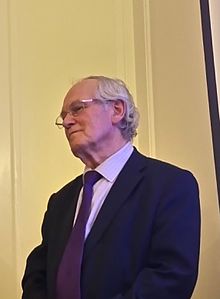John Burland
John Burland (born March 4, 1936 in Buckinghamshire ) is a British civil engineer specializing in geotechnical engineering .
Burland's family emigrated to South Africa after World War II, where he went to school in Johannesburg . He studied civil engineering at the Witwatersrand University with a degree in 1958. From 1961 he worked for the engineering firm Ove Arup and Partners in London. He returned to the university, received his doctorate in 1968 from the University of Cambridge with Kenneth Roscoe (Deformation of soft clay) and went to the Building Research Establishment (BRE) in Watford , where he took over the geotechnical department in 1972 and was ultimately deputy director. In 1980 he became professor of soil mechanics at Imperial College .
As an engineering scientist, he worked on the Critical State Soil Mechanics of his teacher Roscoe and improved (in his dissertation) the Cam Clay model of clay behavior. In the mid-1970s he was in charge of some deep construction pits in central London, for example the underground car park under Westminster Palace (Parliament), where early finite element calculations for construction pits were carried out and compared with deformation measurements on the construction pit or underground car park . He was later involved in securing important structures such as Big Ben and Parliament along the extension of the London Underground Jubilee Line.
He also became known when he was involved in the geotechnical rescue measures for the Leaning Tower of Pisa for twelve years in the 1990s . He was a member of the Italian geotechnical commission for the rescue of the tower (headed by Michele Jamiolkowski ) and developed a system of soil extraction from the north side of the tower (which is inclined to the south) so that it was raised again by its own weight. Work began in February 1999 after the tower was secured with steel cables. The incline was reduced to the level of 1838 (4 m from the vertical at the 60 m high peak). In 2001 it was reopened to the public. Burland received high Italian medals for this. He was also on the commission to secure the foundations of the cathedral in Mexico City (known for its earthquake hazard and a difficult building site on a former lake with volcanic ash deposits).
Honors
- 1989 Kelvin Medal
- 1990 Rankine Lecturer ( On the compressibility and shear strength of natural clays , Geotechnique, Volume 40, 1990, pp. 329-378)
- 1997 Gold Medal from the Institution of Structural Engineers
- In 2000 he gave the Annual Lecture at the Henderson Colloquium of the IABSE (A tale of two towers).
- 2001 the gold medal of the Institution of Civil Engineers (ICE).
- 2002 Vice President of ICE
- In 2002 he became President of the Engineering Department of the British Association for the Advancement of Science.
- 2003 Lord Lloyd of Kilgerran Prize of the Foundation of Science and Technology
- 2003 member of the Academia Europaea
- 2003 Commendadore of the Ordine della Stella di Solidarieta Italiana
- 2005 Commander of the British Empire (CBE)
- 2016 member of the National Academy of Engineering
Web links
Individual evidence
- ↑ At that time a state research institute, now privatized and owned by a foundation, of which Burland is one of the trustees.
- ↑ On the Rescue of the Leaning Tower of Pisa, Architecture Week 2001
- ↑ In the subsurface there are layers of marine clay under a layer of sand. Due to the inhomogeneous course of the layers, the soil settled more heavily on the south side. Extraction from the sand layer led to an increase in pressure on the clay that consolidated on it
- ↑ Burland reports on the work in Preserving Pisa's Treasure , Civil Engineering Magazine, March 2002, p. 72.
- ^ IABSE, Annual Lecture
| personal data | |
|---|---|
| SURNAME | Burland, John |
| ALTERNATIVE NAMES | Burland, JB; Burland, John Boscawen |
| BRIEF DESCRIPTION | British civil engineer |
| DATE OF BIRTH | March 4, 1936 |
| PLACE OF BIRTH | Buckinghamshire |
